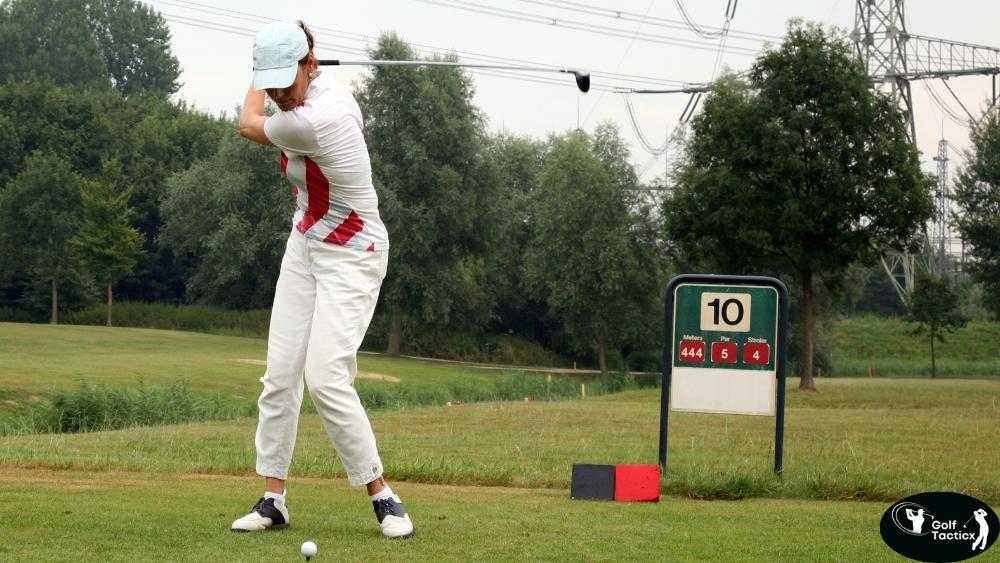Welcome to our first lesson on enhancing your golf game! In our previous post, we focused on Enhancing Lag and Shaft Lean. Today, we’ll focus on how you can execute precise trajectory control on command. Understanding and mastering this skill will allow you to adapt to various course conditions and improve your overall performance.
Controlling your ball’s height and flight path is a key part of becoming a more consistent and confident golfer. Whether you’re facing windy conditions, trying to hit under tree branches, or aiming for a soft landing on the green, knowing how to control golf ball trajectory gives you the upper hand.
This guide will cover essential techniques, simple drills, and helpful tips that both beginners and advanced players can apply. By the end of this lesson, you’ll have a clearer understanding of how to control golf ball trajectory and be ready to take your shot-making skills to the next level.
What Is Trajectory Control?
In golf, trajectory refers to the path your ball follows through the air after you strike it. Controlling this trajectory means you can influence how high or low the ball flies, how much it curves, and how it lands. This skill is essential for navigating different course layouts, weather conditions, and obstacles.
Why Is Trajectory Control Important?
Mastering trajectory control offers several benefits:
Adaptability: Adjust your shots to suit various course conditions, such as wind or elevation changes.
Precision: Place the ball exactly where you want it, avoiding hazards and setting up easier subsequent shots.
Consistency: Develop a reliable game plan by understanding how your ball reacts under different circumstances.
Key Factors Influencing Trajectory
Several elements affect your ball’s trajectory:
Club Selection: Different clubs produce varying launch angles and spin rates.
Ball Position: Where you position the ball in your stance can influence the shot’s height and direction.
Swing Path: The direction and angle of your swing impact the ball’s flight.
Clubface Angle: The angle of the clubface at impact determines the initial direction and spin of the ball.
Techniques to Control Your Ball’s Trajectory
Here are some practical techniques to help you control your shots:
Adjust Your Ball Position:
For Lower Trajectories: Position the ball slightly back in your stance.
For Higher Trajectories: Place the ball slightly forward in your stance.
Modify Your Swing Path:
For Lower Shots: Focus on a steeper swing path.
For Higher Shots: Use a shallower swing path.
Alter Your Clubface Angle:
For Lower Shots: Close the clubface slightly at address.
For Higher Shots: Open the clubface slightly at address.
Control Your Follow-Through:
For Lower Shots: Keep your follow-through compact and low.
For Higher Shots: Allow for a fuller, higher follow-through.
Practical Drills to Enhance Trajectory Control
Incorporating specific drills into your practice routine can significantly improve your ability to control trajectory:
The Low Punch Shot Drill:
Objective: Practice hitting low, controlled shots.
How to Perform:
- Use a mid-iron.
- Position the ball slightly back in your stance.
- Focus on a steeper swing path and a compact follow-through.
The High Fade Drill:
Objective: Develop the ability to hit high, fading shots.
How to Perform:
- Use a short iron.
- Position the ball slightly forward in your stance.
- Open the clubface slightly and focus on a shallower swing path.
The Low Draw Drill:
Objective: Learn to hit low, drawing shots.
How to Perform:
- Use a mid-iron.
- Position the ball slightly back in your stance.
- Close the clubface slightly and focus on an in-to-out swing path.
Equipment Considerations
Selecting the right equipment can aid in trajectory control:
- Clubs: Consider using clubs with adjustable lofts to fine-tune your shot heights.
- Golf Balls: Choose balls that match your skill level and desired spin characteristics.
Mental Strategies for Trajectory Control
Controlling ball flight begins in the mind just as much as in the swing. Visualization is one of the most effective mental techniques you can use, imagine the exact shot shape and trajectory before stepping up to the ball. This practice helps train your body to respond with precision and confidence.
Staying composed under pressure is equally important. When you’re mentally focused, you’re less likely to over-swing or misjudge the shot. Mastering the mental side of how to control golf ball trajectory can be the difference between a solid round and a frustrating one.
Advanced Wind-Adjustment Tips
Adapting to wind conditions is a true test of a golfer’s ability. Here’s how to stay in control:
- Headwind: Take more club, reduce spin with a smoother swing, and keep the ball flight low.
- Tailwind: Club down and use a three-quarter swing to prevent overshooting the target.
- Crosswind: Shape the ball—play a draw or fade depending on the wind direction.
Understanding how to control golf ball trajectory in windy conditions allows you to maintain accuracy and distance when the weather works against you.
Ball Flight vs. Club Selection
| Desired Trajectory | Club Selection | Typical Use Case | Swing Adjustment Needed |
|---|---|---|---|
| High Shot | PW, 9-iron | Clearing hazards, soft landings | Open stance, full finish |
| Low Shot | 4-iron, 5-iron | Windy days, under trees | Ball back, short follow-through |
| Mid-Flight Shot | 7-iron, 8-iron | Standard approach shots | Neutral stance, smooth swing |
| Stinger | Long iron or hybrid | Piercing wind, tight fairways | Forward lean, abbreviated finish |
Common Mistakes to Avoid
Be mindful of these common errors:
Overcomplicating Adjustments: Making too many changes at once can disrupt your swing. Focus on one adjustment at a time.
Ignoring Course Conditions: Always consider factors like wind and elevation when planning your shots.
Neglecting Practice: Consistent practice is key to mastering trajectory control.
Conclusion
Mastering how to control golf ball trajectory gives you the confidence to shape your game around any challenge the course throws your way. With deliberate practice and an understanding of ball flight dynamics, you’ll be better equipped to take on varied playing conditions.
As you continue to refine this skill, pay attention to how small adjustments in stance, grip, and clubface angle influence the ball’s flight. Developing a strong sense of how to control golf ball trajectory not only improves your distance management but also builds your ability to handle pressure-packed shots with accuracy and ease.
Making trajectory control a regular part of your training will lead to smarter shot selection and a more adaptable game overall.
Up next, we’ll dive into the art of the low-spin stinger, a piercing shot that rides low, cuts through wind, and lands with precision.
















Leave a Reply